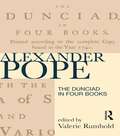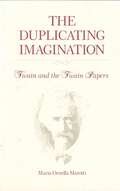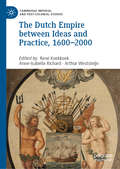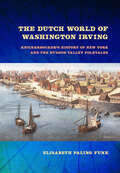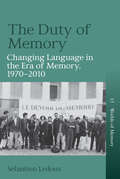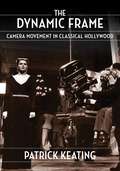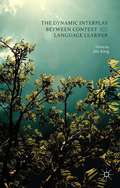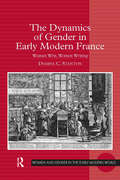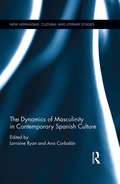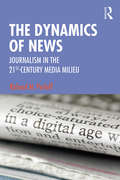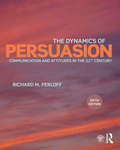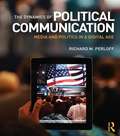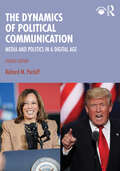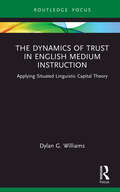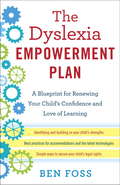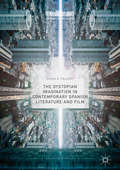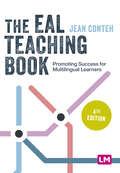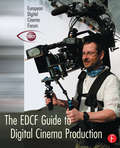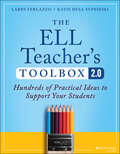- Table View
- List View
The Dunciad in Four Books: The Dunciad (1728) And The Dunciad Variorum (1729) (Longman Annotated Texts)
by Valerie RumboldThe Dunciad in Four Books of 1743 was the culmination of the series of Dunciads which Alexander Pope produced over the last decade and a half of his life. It comprises not only a poem, but also a mass of authorial annotation and appendices, and this authoritative edition is the only one available which gives all the verse and the prose in a clearly laid-out form, with a full modern commentary. Accessibly presented on the same page as Pope’s text are explanatory notes, written in a style adapted to the needs of undergraduate readers, but still comprehensive enough to address the interests of scholars. The many books and pamphlets to which Pope refers have been examined in detail, and the commentary takes advantage of the fifty years’ scholarship on literary, bibliographical, cultural and political aspects of the period which has accumulated since James Sutherland’s The Dunciad, volume five of the Twickenham Edition. A substantial introduction offers a stimulating and helpful approach to the work, and the bibliography includes extensive suggestions for further reading.
The Duplicating Imagination: Twain and the Twain Papers
by Maria MarottiMaria Marotti applies a unique mixture of strains of contemporary literary theory to the body of posthumously published works so far published in the Mark Twain Papers series, examining these late, frequently incomplete or abandoned, and usually experimental, works in theoretical light. Marotti's approach is a text-centered one, semiotic and structuralist in inspiration, and she brings a fresh Continental perspective to bear on an author usually treated biographically, thematically, psychologically. Her concern is with generic definition, and this guides her shaping of the book into four chapters on burlesque, fantasy and dream voyage, romance, and myth. She advances with success the finding, novel in Twain scholarship, that Mark Twain really was experimenting with aspects of fiction ordinarily thought of today as modern or postmodern, and Twain scholars will see that simply being able to consider his various experiments in the terms posed by these theories is itself grounds for changing or at least for reevaluating how they have looked at these writings in the past. Marotti further demonstrates the effectiveness of her terms and terminology for picking up the story of Twain's roots in folklore and oral storytelling, and for grounding these well-known stories in the entirety of his literary development.Interest in Twain is at an all-time high. This penetrating, authoritative, and lively book has the capacity to appeal to an audience far beyond the narrow range of literary theorists. Marotti's contribution, in addition to the presentation of the Twain Papers as a corpus deserving of the kind of attention that has been directed to Twain's published work, is the promotion of recognition of his as a bold experimenter in literary form, an aspect of his achievement that all too often has been neglected.
The Duplicating Imagination: Twain and the Twain Papers
by Maria MarottiMaria Marotti applies a unique mixture of strains of contemporary literary theory to the body of posthumously published works so far published in the Mark Twain Papers series, examining these late, frequently incomplete or abandoned, and usually experimental, works in theoretical light. Marotti's approach is a text-centered one, semiotic and structuralist in inspiration, and she brings a fresh Continental perspective to bear on an author usually treated biographically, thematically, psychologically. Her concern is with generic definition, and this guides her shaping of the book into four chapters on burlesque, fantasy and dream voyage, romance, and myth. She advances with success the finding, novel in Twain scholarship, that Mark Twain really was experimenting with aspects of fiction ordinarily thought of today as modern or postmodern, and Twain scholars will see that simply being able to consider his various experiments in the terms posed by these theories is itself grounds for changing or at least for reevaluating how they have looked at these writings in the past. Marotti further demonstrates the effectiveness of her terms and terminology for picking up the story of Twain's roots in folklore and oral storytelling, and for grounding these well-known stories in the entirety of his literary development.Interest in Twain is at an all-time high. This penetrating, authoritative, and lively book has the capacity to appeal to an audience far beyond the narrow range of literary theorists. Marotti's contribution, in addition to the presentation of the Twain Papers as a corpus deserving of the kind of attention that has been directed to Twain's published work, is the promotion of recognition of his as a bold experimenter in literary form, an aspect of his achievement that all too often has been neglected.
The Dutch Empire between Ideas and Practice, 1600–2000 (Cambridge Imperial and Post-Colonial Studies Series)
by René Koekkoek Anne-Isabelle Richard Arthur WeststeijnThis volume explores the intellectual history of the Dutch Empire from a long-term and global perspective, analysing how ideas and visions of empire took shape in imperial practice from the seventeenth century to the present day. Through a series of case studies, the volume critically unearths deep-rooted conceptions of Dutch imperial exceptionalism and shows how visions of imperial rule were developed in metropolitan and colonial contexts and practices. Topics include the founding of the Dutch chartered companies for colonial trade, the development of commercial and global visions of empire in Europe and Asia, the continuities and ruptures in imperial ideas and practices around 1800, and the practical making of empire in colonial court rooms and radio broadcasting. Demonstrating the relevance of a long-term approach to the Dutch Empire, the volume showcases how the intellectual history of empire can provide fresh light on postcolonial repercussions of empire and imperial rule.Chapter 1, Chapter 3, Chapter 7 and Chapter 8 of this book are available open access under a CC BY 4.0 license at link.springer.com.
The Dutch World of Washington Irving: Knickerbocker's History of New York and the Hudson Valley Folktales (New Netherland Institute Studies)
by Elisabeth Paling FunkThe Dutch World of Washington Irving tells an alternative origin story of American literary culture. In December of 1809, before finding fame with "Rip Van Winkle" and "The Legend of Sleepy Hollow," Washington Irving published his satirical A History of New York, from the Beginning of the World to the End of the Dutch Dynasty under the pseudonym Diedrich Knickerbocker. Elisabeth Paling Funk explains that the History of New York and the Hudson Valley folktales that followed were part of an early trend of responding to the national desire for a historical record. Funk argues that these works uniquely describe this part of the American scene in the period of the Early Republic and bring forward the Dutch strain in its history and culture.Funk explores what the young Irving would have read, heard, and observed during his early life and career in New York City, once part of the former colony of New Netherland, where he was surrounded by Dutch-speaking neighbors and relatives and Dutch literature. Based on these sources, The Dutch World of Washington Irving argues that Irving's Knickerbocker works—not only his History but also his Hudson Valley stories—represent a crucial effort to preserve Dutch life and folk customs in the Hudson Valley in the face of Anglo-Americanization. Providing the first complete glossary of Irving's Dutch vocabulary and drawing on untranslated Dutch sources, Funk offers cultural historians, scholars of American folklore and literature, and the latest generation of Irving's readers unprecedented access into the Dutch world of Washington Irving and his American contemporaries.
The Duty of Memory: Changing Language in the Era of Memory, 1970 – 2010 (Worlds of Memory)
by Sébastien LedouxWithin France, the expression “duty of memory” (le devoir de mémoire)speaks to a complex and ever-evolving relationship with the past. Emerging in the 1970s, this term raised questions about memorialization which dominated public debates in the 1990s, highlighting France’s entanglements with colonialism and the Holocaust. Drawing on a variety of interviews, archival sources, and data surveys, author Sébastien Ledoux spotlights how the trajectory of this term offers a lens for understanding contemporary societies’ relationship with the past on a global scale.
The Dynamic Frame: Camera Movement in Classical Hollywood (Film and Culture Series)
by Patrick KeatingThe camera’s movement in a film may seem straightforward or merely technical. Yet skillfully deployed pans, tilts, dollies, cranes, and zooms can express the emotions of a character, convey attitude and irony, or even challenge an ideological stance. In The Dynamic Frame, Patrick Keating offers an innovative history of the aesthetics of the camera that examines how camera movement shaped the classical Hollywood style.In careful readings of dozens of films, including Sunrise, The Grapes of Wrath, Rear Window, Sunset Boulevard, and Touch of Evil, Keating explores how major figures such as F. W. Murnau, Orson Welles, and Alfred Hitchcock used camera movement to enrich their stories and deepen their themes. Balancing close analysis with a broader poetics of camera movement, Keating uses archival research to chronicle the technological breakthroughs and the changing division of labor that allowed for new possibilities, as well as the shifting political and cultural contexts that inspired filmmakers to use technology in new ways. An original history of film techniques and aesthetics, The Dynamic Frame shows that the classical Hollywood camera moves not to imitate the actions of an omniscient observer but rather to produce the interplay of concealment and revelation that is an essential part of the exchange between film and viewer.
The Dynamic Interplay between Context and the Language Learner
by Jim KingThis edited volume offers a series of state-of-the-art conceptual papers and empirical research studies which consider how contextual factors at multiple levels dynamically interact with individuals to influence how they go about the complex business of learning and using a second language.
The Dynamics of Gender in Early Modern France: Women Writ, Women Writing (Women and Gender in the Early Modern World)
by Domna C. StantonIn its six case studies, The Dynamics of Gender in Early Modern France works out a model for (early modern) gender, which is articulated in the introduction. The book comprises essays on the construction of women: three in texts by male and three by female writers, including Racine, Fénelon, Poulain de la Barre, in the first part; La Guette, La Fayette and Sévigné, in the second. These studies thus also take up different genres: satire, tragedy and treatise; memoir, novella and letter-writing. Since gender is a relational construct, each chapter considers as well specific textual and contextual representations of men. In every instance, Stanton looks for signs of conformity to-and deviations from-normative gender scripts. The Dynamics of Gender adds a new dimension to early modern French literary and cultural studies: it incorporates a dynamic (shifting) theory of gender, and it engages both contemporary critical theory and literary historical readings of primary texts and established concepts in the field. This book emphasizes the central importance of historical context and close reading from a feminist perspective, which it also interrogates as a practice. The Afterword examines some of the meanings of reading-as-a-feminist.
The Dynamics of Genre: Journalism and the Practice of Literature in Mid-Victorian Britain (Victorian Literature and Culture Series)
by Dallas LiddleNewspapers, magazines, and other periodicals reached a peak of cultural influence and financial success in Britain in the 1850s and 1860s, out-publishing and out-selling books as much as one hundred to one. But although scholars have long known that writing for the vast periodical marketplace provided many Victorian authors with needed income--and sometimes even with full second careers as editors and journalists--little has been done to trace how the midcentury ascendancy of periodical discourses might have influenced Victorian literary discourse.In The Dynamics of Genre, Dallas Liddle innovatively combines Mikhail Bakhtin's dialogic approach to genre with methodological tools from periodicals studies, literary criticism, and the history of the book to offer the first rigorous study of the relationship between mid-Victorian journalistic genres and contemporary poetry, the novel, and serious expository prose. Liddle shows that periodical genres competed both ideologically and economically with literary genres, and he studies how this competition influenced the midcentury writings and careers of authors including Elizabeth Barrett Browning, Harriet Martineau, Anthony Trollope, George Eliot, and the sensation novelists of the 1860s. Some Victorian writers directly adopted the successful genre forms and worldview of journalism, but others such as Eliot strongly rejected them, while Trollope launched his successful career partly by using fiction to analyze journalism's growing influence in British society. Liddle argues that successful interpretation of the works of these and many other authors will be fully possible only when scholars learn to understand the journalistic genre forms with which mid-Victorian literary forms interacted and competed.
The Dynamics of Inheritance on the Shakespearean Stage
by Michelle M. DowdEarly modern England's system of patrilineal inheritance, in which the eldest son inherited his father's estate and title, was one of the most significant forces affecting social order in the period. Demonstrating that early modern theatre played a unique and vital role in shaping how inheritance was understood, Michelle M. Dowd explores some of the common contingencies that troubled this system: marriage and remarriage, misbehaving male heirs, and families with only daughters. Shakespearean drama helped question and reimagine inheritance practices, making room for new formulations of gendered authority, family structure, and wealth transfer. Through close readings of canonical and non-canonical plays by Shakespeare, Webster, Jonson, and others, Dowd pays particular attention to the significance of space in early modern inheritance and the historical relationship between dramatic form and the patrilineal economy. Her book will interest researchers and students of early modern drama, Shakespeare, gender studies, and socio-economic history.
The Dynamics of Masculinity in Contemporary Spanish Culture (New Hispanisms: Cultural and Literary Studies)
by Lorraine Ryan Ana CorbalanThis collection of essays explores cultural phenomena that are shaping masculine identities in contemporary Spain, asking and striving to answer these compelling questions: what does it mean to be a man in present-day Spain? How has masculinity evolved since Franco’s dictatorship? What are the dynamics of masculinity in contemporary Spanish culture? How has hegemonic masculinity been contested in cultural productions? This volume is comprised of sixteen essays that address these very questions by examining literary, cultural and film representations of the configurations of masculinities in contemporary Spain. Divided into three thematic units, starting with the undermining of the monolithic Francoist archetype of masculinity, continuing with the reformulation of hegemonic masculinity and finishing with regional emergent masculinities, all of the volume´s essays focus on the redefinition of Spanish masculinities. Principal themes of the volume include alternative families, queer masculinities, performative masculinities, memory and resistance to hegemonic discourses of manliness, violence and emotions, public versus private masculinities, regional masculinities, and marginal masculinities. This exploration not only produces new insights into masculinity, but also yields nuanced insights into the recuperation of memory in contemporary Spain, the reconfiguration of the family, the status of women in Spanish society, and regional identities.
The Dynamics of News: Journalism in the 21st Century Media Milieu
by Richard PerloffThis new and highly readable textbook by Richard M. Perloff introduces students to the complex world of contemporary news and its theoretical underpinnings, engaging with debates and ethical quandaries. The book takes readers on a concept-guided tour of the contours, continuities, and changing features of news. It covers a huge breadth of topics including: the classic theories of what news should do, its colorful history in America and popular myths of news, the overarching forces involved in contemporary news gathering, critical economic determinants of news and social system influences, and innovative trends in the future of journalism. Drawing on scholarship in the fields of journalism studies and sociology of news, Perloff offers readers a critical, in-depth exploration of news filled with relevant examples from newspapers, newscasts, and social media. Students of journalism, communication, sociology, politics, and related courses, as well as inquisitive scholars, will find this book’s intellectual focus enriching, the writing and examples engaging, and the thoroughness of its search of the contemporary media scene invigorating. Boxes summarizing theory and key concepts help students to deepen their understanding of both what news is now and its future.
The Dynamics of Persuasion: Communication and Attitudes in the Twenty-First Century (Routledge Communication Series)
by Richard M. PerloffThe Dynamics of Persuasion has been a staple resource for teaching persuasion for nearly two decades. Author Richard M. Perloff speaks to students in a style that is engaging and informational, explaining key theories and research as well as providing timely and relevant examples. The companion website includes materials for both students and instructors, expanding the pedagogical utilities and facilitating adoptions. The sixth edition includes: updated theoretical and applied research in a variety of areas, including framing, inoculation, and self-affirmation; new studies of health campaigns; expanded coverage of social media marketing; enhanced discussion of the Elaboration Likelihood Model in light of continued research and new applications to everyday persuasion. The fundamentals of the book – emphasis on theory, clear-cut explanation of findings, in-depth discussion of persuasion processes and effects, and easy-to-follow real-world applications – continue in the sixth edition.
The Dynamics of Political Communication: Media and Politics in a Digital Age
by Richard M. Perloff"The Dynamics of Political Communication blends the drama, excitement, and chaos of politics with the extensive body of social science research that maps in detail the role of the communication media in our political life." --Maxwell McCombs, University of Texas at Austin "The effortlessness and accessibility with which this text walks the reader through theories, current examples and exercises will also make it a very popular textbook for undergraduate courses. I look forward to assigning it in my classes."--Dietram A. Scheufele, University of Wisconsin-Madison "Written in an easily accessible style and filled with timely and interesting examples, this textbook would be a first-rate addition to any introductory course on the topic."--Gadi Wolfsfeld, Author of Making Sense of Media and Politics: Five Principles in Political Communication "...an engaging and timely analysis of the central role of media in American politics. ... The book provides multiple perspectives to stimulate critical thought and reflection."--Ann N. Crigler, University of Southern California "Perloff has offered a systematic overview of the topic that allows us to make sense of the chaotic communication environment we are enveloped within. ... A must-read for anyone looking to introduce themselves to this important research area."--R. Lance Holbert, The Ohio State University What impact do news and political advertising have on us? How do candidates use media to persuade us as voters? Are we informed adequately about political issues? Do 21st-century political communications measure up to democratic ideals? The Dynamics of Political Communication: Media and Politics in a Digital Age explores these issues and guides us through current political communication theories and beliefs. Author Richard M. Perloff details the fluid landscape of political communication and offers us an engaging introduction to the field and a thorough tour of the discipline. He examines essential concepts in this arena, such as agenda-setting, agenda-building, framing, political socialization, and issues of bias that are part of campaign news. Designed to provide an understanding and appreciation of the principles involved in political communication along with methods of research and hypothesis-testing, each chapter includes materials that challenge us by encouraging reflection on controversial matters and providing links to online examples of real-life political communication. The text's companion website provides expanded resources for students as well as materials for instructors to use in the classroom. The Dynamics of Political Communication immerses readers in contemporary events through its coverage of online campaigning, effects of negative advertising, issues of gender bias in campaign politics, and image-management strategies in the 2012 campaign. It will prepare you to survey the current political landscape with a more critical eye, and encourage a greater understanding of the challenges and occurrences presented in this constantly evolving field.
The Dynamics of Political Communication: Media and Politics in a Digital Age
by Richard M. PerloffWhat impact do news and political advertising have on us? How do candidates use media to persuade us as voters? Are we informed adequately about political issues? Do twenty-first-century political communications measure up to democratic ideals? The Dynamics of Political Communication: Media and Politics in a Digital Age, Second Edition explores these issues and guides us through current political communication theories and beliefs by detailing the fluid landscape of political communication and offering us an engaging introduction to the field and a thorough tour of the discipline. Author Richard Perloff examines essential concepts in this arena, such as agenda-setting, agenda-building, framing, political socialization, and issues of bias that are part of campaign news. Designed to provide an understanding and appreciation of the principles involved in political communication along with methods of research and hypothesis-testing, each chapter includes materials that challenge us by encouraging reflection on controversial matters. Inside this Second Edition you’ll find: Expanded discussion of conceptual problems, communication complexities, and key issues in the field. New examples, concepts, and studies reflecting current political communication scholarship. The integration of technology throughout the text, reflecting its pervasive role in the political spectrum. Accompanied by an updated companion website with resources for students and instructors, The Dynamics of Political Communication prepares you to survey the political landscape with a more critical eye, and encourages a greater understanding of the challenges and occurrences presented in this constantly evolving field.
The Dynamics of Political Communication: Media and Politics in a Digital Age
by Richard M. PerloffThis fully updated fourth edition continues to provide comprehensive coverage of communication and politics, again focusing on the way politics and media impact democracy.The book explores the intersection between politics and communication, drawing from leading scholarship in communication, political science, and political psychology. It describes the nature of today’s political media; political socialization; key media effects, such as agenda-setting and framing; myths, biases and facts in political news; political advertising and presidential debates. This edition includes new and expanded discussions of free speech and misinformation on social media, presidential rhetoric, the 2022 and 2024 election campaigns and the January 6th investigation narrative. It also examines international examples such as the Ukraine War, populism in Hungary and Turkey, Russian propaganda, and TikTok.The book is ideally suited for upper-level undergraduate and graduate political communication courses in communication, journalism, and political science programs.This edition again features online resources with links to relevant news articles, videos, or other online materials. For instructors, an instructor’s manual, including sample syllabi, chapter outlines, sample discussion questions, sample test questions, and lecture slides are also provided. Access the support materials at www.routledge.com/9781032613130.
The Dynamics of Trust in English Medium Instruction: Applying Situated Linguistic Capital Theory (Routledge Focus on English-Medium Instruction in Higher Education)
by Dylan WilliamsThis book explores South Korean university students’ perceptions of the English Medium Instruction (EMI) courses they have taken. It specifically examines how the interplay of linguistic capital and trust shapes their EMI experiences.In South Korea, the implementation of neoliberal EMI policies, driven by a 'top-down' approach, has failed to adequately address the linguistic challenges faced by stakeholders. The setting for the book is a research-intensive university, where data were collected from ten engineering and business students through semi-structured interviews and analysed using Constructivist Grounded Theory (CGT), enabling a grounded understanding of the students’ perceptions. The areas investigated are students’ perceptions of their past experiences, of their access to subject content, and of how interactions take shape in their EMI experiences. Emerging from the analysis is a dynamic between trust and linguistic capital, which has been shaped by the past and which affects the future, leading to epistemic outcomes. The results indicate that monolingually framed trust in situated-linguistic codes plays a role in the students’ EMI experiences, and from this ‘Situated-Linguistic Capital Theory’ emerges. The theory indicates that monolingually framed trust reinforces binary choices, in particular EMI situations, of using either the L1 or the L2 system, which can lead to potential epistemic outcomes. The book concludes with a discussion of the factors that can determine the future success of EMI in South Korea.This volume will be of interest to researchers and postgraduate students examining English Medium Instruction and its success in different higher education contexts.
The Dynastic Imagination: Family and Modernity in Nineteenth-Century Germany
by Adrian DaubAdrian Daub’s The Dynastic Imagination offers an unexpected account of modern German intellectual history through frameworks of family and kinship. Modernity aimed to brush off dynastic, hierarchical authority and to make society anew through the mechanisms of marriage, siblinghood, and love. It was, in other words, centered on the nuclear family. But as Daub shows, the dynastic imagination persisted, in time emerging as a critical stance by which the nuclear family’s conservatism and temporal limits could be exposed. Focusing on the complex interaction between dynasties and national identity-formation in Germany, Daub shows how a lingering preoccupation with dynastic modes of explanation, legitimation, and organization suffused German literature and culture. ? Daub builds this conception of dynasty in a syncretic study of literature, sciences, and the history of ideas, engaging with remnants of dynastic ideology in the work of Richard Wagner, Émile Zola, and Stefan George, and in the work of early feminists and pioneering psychoanalysts. At every stage of cultural progression, Daub reveals how the relation of dynastic to nuclear families inflected modern intellectual history.
The Dyslexia Empowerment Plan
by Ben FossFinally, a groundbreaking book that reveals what your dyslexic child is experiencing--and what you can do so that he or she will thrive More than thirty million people in the United States are dyslexic--a brain-based genetic trait, often labeled as a "learning disability" or "learning difference," that makes interpreting text and reading difficult. Yet even though children with dyslexia may have trouble reading, they don't have any problems learning; dyslexia has nothing to do with a lack of intellect. While other books tell you what dyslexia is, this book tells you what to do. Dyslexics' innate skills, which may include verbal, social, spatial, kinesthetic, visual, mathematical, or musical abilities, are their unique key to acquiring knowledge. Figuring out where their individual strengths lie, and then harnessing these skills, offers an entrée into learning and excelling. And by keeping the focus on learning, not on standard reading the same way everyone else does, a child with dyslexia can and will develop the self-confidence to flourish in the classroom and beyond. After years of battling with a school system that did not understand his dyslexia and the shame that accompanied it, renowned activist and entrepreneur Ben Foss is not only open about his dyslexia, he is proud of it. In The Dyslexia Empowerment Plan he shares his personal triumphs and failures so that you can learn from his experiences, and provides a three-step approach for success: * Identify your child's profile: By mapping your child's strengths and weaknesses and assisting her to better understand who she is, you can help your child move away from shame and feelings of inadequacy and move toward creating a powerful program for learning. * Help your child help himself: Coach your child to become his own best advocate by developing resiliency, confidence, and self-awareness, and focusing on achievable goals in areas that matter most to him. * Create community: Dyslexic children are not broken, but too often the system designed to educate them is. Dare to change your school so that your child has the resources to thrive. Understanding your rights and finding allies will make you and your child feel connected and no longer alone. Packed with practical ideas and strategies dyslexic children need for excelling in school and in life, this empowering guide provides the framework for charting a future for your child that is bright with hope and unlimited potential.Advance praise for The Dyslexia Empowerment Plan "I study dyslexia in the lab and am a parent of a wonderful daughter who fits this profile. Ben Foss's book should be considered essential to any collection on the subject. It was extremely useful, especially for a mom. Thank you!"--Maria Luisa Gorno Tempini, M.D., Ph.D., professor of neurology, UCSF, Memory and Aging Center "As someone with a learning profile that made school tough, and as a parent, I know kids need the right support. Ben Foss knows how to get access to education because he's been through it. I was thrilled to read this book. It offers a wise collection of insights that are both practical and touching. Buy it today if you want a get a plan for your child."--James Gandolfini, actor, The Sopranos
The Dystopian Imagination in Contemporary Spanish Literature and Film (Hispanic Urban Studies)
by Diana Q. PalardyThis study examines contemporary Spanish dystopian literature and films (in)directly related to the 2008 financial crisis from an urban cultural studies perspective. It explores culturally-charged landscapes that effectively convey the zeitgeist and reveal deep-rooted anxieties about issues such as globalization, consumerism, immigration, speculation, precarity, and political resistance (particularly by Indignados [Indignant Ones] from the 15-M Movement). The book loosely traces the trajectory of the crisis, with the first part looking at texts that underscore some of the behaviors that indirectly contributed to the crisis, and the remaining chapters focusing on works that directly examine the crisis and its aftermath. This close reading of texts and films by Ray Loriga, Elia Barceló, Ion de Sosa, José Ardillo, David Llorente, Eduardo Vaquerizo, and Ricardo Menéndez Salmón offers insights into the creative ways that these authors and directors use spatial constructions to capture the dystopian imagination.
The EAL Teaching Book: Promoting Success for Multilingual Learners (Primary Teaching Now)
by Jean ContehAs the number of children for whom English is an Additional Language in schools increases, how do teachers and trainees prepare to support them to succeed? A complete guide to understanding, learning from and teaching bilingual and EAL children in schools. The text begins by asking ′who are EAL learners′ and challenges some of the misconceptions about this group. It goes on to examine language in depth, providing focused theory to help teachers and trainees better understand the wider context of children′s needs. This theory is supported by a wealth of information on practical teaching strategies and resources in the promoting learning section. The text covers planning across the curriculum for EAL and offers day-to-day practical support for teachers. The fourth edition is updated throughout and includes a new chapter on EAL and SEND.
The EAL Teaching Book: Promoting Success for Multilingual Learners (Primary Teaching Now)
by Jean ContehAs the number of children for whom English is an Additional Language in schools increases, how do teachers and trainees prepare to support them to succeed? A complete guide to understanding, learning from and teaching bilingual and EAL children in schools. The text begins by asking ′who are EAL learners′ and challenges some of the misconceptions about this group. It goes on to examine language in depth, providing focused theory to help teachers and trainees better understand the wider context of children′s needs. This theory is supported by a wealth of information on practical teaching strategies and resources in the promoting learning section. The text covers planning across the curriculum for EAL and offers day-to-day practical support for teachers. The fourth edition is updated throughout and includes a new chapter on EAL and SEND.
The EDCF Guide to Digital Cinema Production
by Lasse SvanbergA professional introduction to the end-to-end process of digital filmmaking!The EDCF Guide to Digital Cinema Production sheds light on the ongoing and confusing transition from analog to digital technology in film production. In addition to a complete analysis of technical concerns, this text deals with a number of issues where European and Hollywood priorities differ. It adds fuel to the discussion on "Photo-Chemical Fundamentalism" and the future of traditional film-based cinematography.With special emphasis on new HD production techniques for the big cinema screen, this guide is the one and only resource available from a European perspective. The EDCF Guide to Digital Cinema Production provides film professionals and decisions-makers in European cinema with an excellent basis for discussions on how to handle the transition from analog to digital technology. Look no further for:* Several production case studies, among them Ingmar Bergman's last film "Saraband" (2003) and Lars von Trier's "Dogville" (2003).* Surveys of HD Systems & Cameras and "The 37 MFAQ on HD Production."* Expert reports on Audio Recording for HD and the Digital Intermediate Process.* Detailed European initiatives in Digital Cinema.* An up-to-date survey of the problematic standards situation for Digital Cinema.* A comprehensive look at archiving - the "Achilles Heel" of digital production.* The pros and cons of producing feature films digitally - a unique and professional view of "the agony and ecstacy."Editor-in-Chief Lasse Svanberg is a founding member of EDCF. He was DoP on 14 feature films 1966-81, founded TM (Technolgy & Man) Magazine at the Swedish Film Institute in 1968 and was its Chief Editor until 1998 He was elected Fellow of BKSTS 1979, Fellow of SMPTE 1995 and granted Professor's title by the Swedish Government 2002. He is the author of six books on the history and possible future of film, video and television.The European Digital Digital Cinema Forum (EDCF) was constituted in June 2001 as joint Swedish-British-French effort to establish a European forum for discussions, information exchange and industrial activities in the field of Digital Cinema. This project was initiated because digital production, digital distribution and digital exhibition of film is the most radical technical change facing the film industry since sound film was introduced.
The ELL Teacher's Toolbox 2.0: Hundreds of Practical Ideas to Support Your Students (The Teacher's Toolbox Series)
by Larry Ferlazzo Katie Hull SypnieskiSet your English language learners up for success with this effective resource The ELL Teacher's Toolbox 2.0 is a valuable, updated resource that teachers of English Language Learners (ELLs) can use to improve student outcomes. With hundreds of innovative strategies and activities to bring to your classroom, this book can be used with learners of all levels and in any instructional setting. This revised edition provides the latest enhancements to the instructional tools—along with 16 new chapters that you can add to your teaching repertoire. New content includes coverage of artificial intelligence, online learning environments, and differentiated instruction. Graphics and visuals make it easy to understand and adapt the content to your unique teaching situation. Written by proven authors in the field, the book is divided into two main sections: Reading/Writing and Speaking/Listening. Each of those sections includes “Top Ten” favorites and between 40 and 70 strategies that can be used as part of multiple lessons and across content areas. Contains 60% new strategies Features ready-to-use lesson plans Includes reproducible handouts Offers technology integration ideas For the growing number of ELLs in public schools, effective ELL instruction can mean the difference between long-term academic success and continued struggling. In this book, you'll find countless practical ideas to add to your teaching arsenal—or for training and coaching ELL teachers—so you can support your students on their journey.
